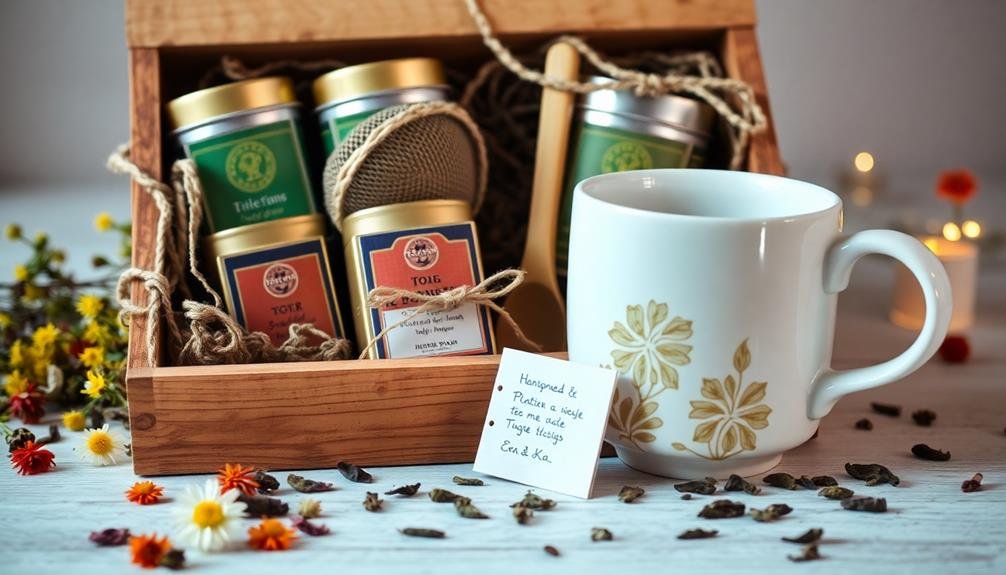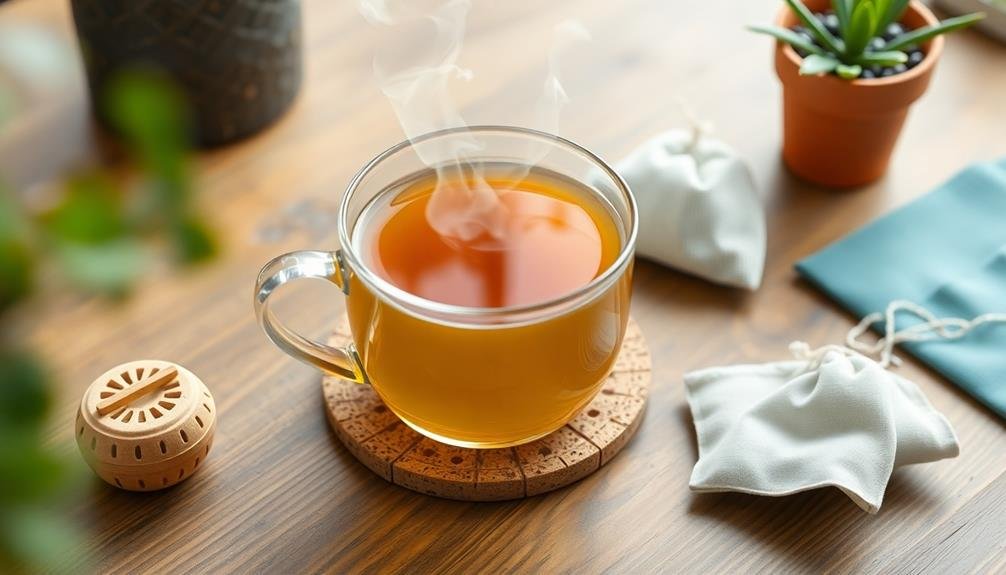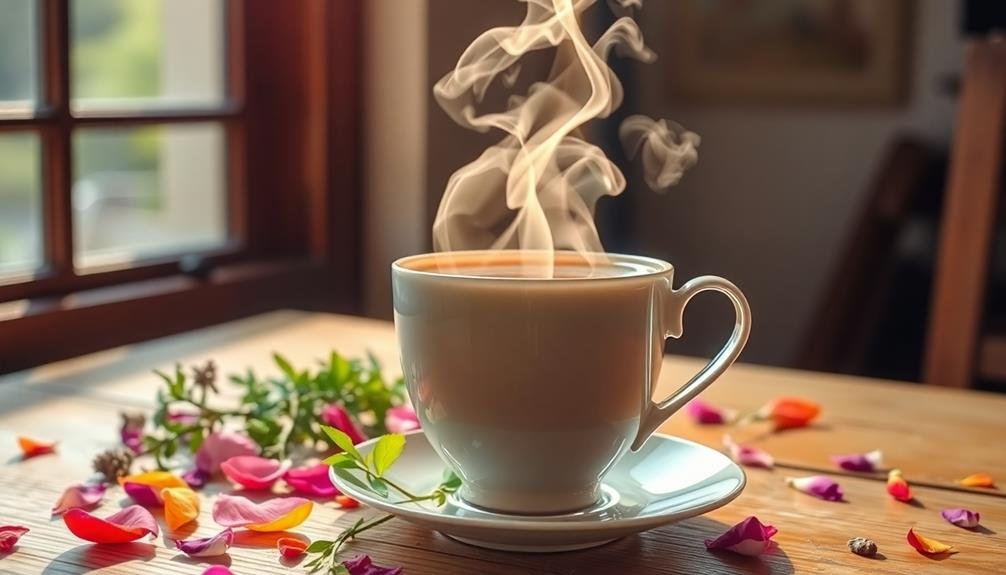You can easily craft herbal infusions at home using five simple techniques. Try sun steeping for a gentle extraction, or cold brewing for milder flavors. The hot water steep approach offers quick results, while decoction works best for tough herbs like roots and bark. For a hands-off method, consider overnight infusions. Each technique requires minimal equipment and allows you to customize your herbal blends. Whether you're seeking health benefits or simply enjoying natural flavors, these DIY methods put the power of herbal infusions in your hands. Discover how each technique can reveal the full potential of your favorite herbs.
Sun Steeping Method

The sun steeping method harnesses the power of natural sunlight to infuse herbs into water or oil. It's a gentle, energy-efficient technique that's perfect for delicate herbs and flowers.
To begin, you'll need a clean glass jar, your chosen herbs, and water or oil as the base. Fill the jar with fresh or dried herbs, leaving about an inch of space at the top. Pour room temperature water or oil over the herbs, ensuring they're fully submerged.
Seal the jar tightly and place it in a sunny spot outdoors or on a windowsill that receives direct sunlight. Let the jar sit in the sun for 3-8 hours, depending on the strength you desire. Avoid leaving it out overnight, as the cool temperatures can cause condensation and potentially spoil your infusion.
Once you're satisfied with the color and aroma, strain the liquid through a fine-mesh sieve or cheesecloth. Store your sun-steeped infusion in a cool, dark place.
Water-based infusions will last about a week in the refrigerator, while oil-based ones can be kept for several months. Remember to label your jar with the date and ingredients used.
Cold Brew Infusion Technique
For those seeking a milder flavor profile, cold brew infusion offers an excellent alternative to heat-based methods. This technique involves steeping herbs in cold water for an extended period, typically 8 to 24 hours, depending on the desired strength.
To start, choose your favorite herbs and place them in a clean glass jar. Use about 1 tablespoon of dried herbs or 2 tablespoons of fresh herbs per cup of water. Fill the jar with cold, filtered water and seal it tightly. Give it a gentle shake to guarantee all herbs are submerged.
Store the jar in the refrigerator and let it steep. You can strain the infusion after 8 hours for a lighter flavor or leave it for up to 24 hours for a stronger brew. Once you've reached your desired steeping time, strain the herbs using a fine-mesh strainer or cheesecloth.
The cold brew method extracts fewer tannins and bitter compounds, resulting in a smoother, less astringent taste. It's particularly well-suited for delicate herbs like mint, lemon balm, and chamomile.
You can enjoy your cold brew infusion immediately over ice or store it in the refrigerator for up to three days.
Hot Water Steep Approach

Most herbal tea enthusiasts prefer the hot water steep approach for its quick and effective extraction of flavors and beneficial compounds. This method is straightforward and requires minimal equipment. You'll need a heat-safe container, boiling water, and your chosen herbs.
Begin by bringing water to a boil. While waiting, measure out your herbs – typically 1-2 teaspoons per cup of water. Place the herbs in your container, then pour the hot water over them. Cover the container to trap the steam and aromatic compounds. Let it steep for 5-15 minutes, depending on the herb and desired strength.
For delicate herbs like chamomile or mint, use water just below boiling and steep for 5-7 minutes. Hardier herbs like roots or bark may require a full boil and 10-15 minutes of steeping. Experiment to find your perfect balance.
Once steeped, strain the liquid into your cup. You can add honey, lemon, or other natural sweeteners if desired.
Decoction for Tough Herbs
Decoction's power lies in its ability to extract potent compounds from tougher plant materials. This method is ideal for working with roots, bark, and seeds that don't readily release their beneficial properties through simple steeping. You'll find it particularly useful for herbs like ginger, cinnamon, and licorice root.
To create a decoction, you'll need to simmer your herbs in water for an extended period. Start by placing your chosen tough herbs in a pot with cold water. Use about one ounce of dried herbs per pint of water. Bring the mixture to a boil, then reduce the heat and let it simmer gently for 15 to 60 minutes, depending on the herb's density.
As the water evaporates, you'll notice the liquid becoming more concentrated. This process allows for maximum extraction of the herb's medicinal components.
Once you've finished simmering, strain the liquid and discard the plant material. You can drink your decoction immediately or store it in the refrigerator for up to 72 hours. Remember, decoctions are typically stronger than infusions, so you may want to dilute them before consuming.
Overnight Herbal Infusion Process

While decoctions work well for tough plant materials, some herbs benefit from a gentler, longer extraction process. The overnight herbal infusion method is perfect for extracting nutrients from leafy herbs and flowers.
To start, you'll need a quart-sized glass jar, your chosen herbs, and boiling water.
Place 1 ounce of dried herbs or 2 ounces of fresh herbs into the jar. Pour boiling water over the herbs, filling the jar to the top. Stir gently to guarantee all herbs are submerged. Seal the jar tightly and let it sit at room temperature for 8 to 12 hours, or overnight.
In the morning, strain the liquid through a fine-mesh strainer or cheesecloth into another container. Squeeze the herbs to extract any remaining liquid. Your infusion is now ready to drink. You can enjoy it hot, cold, or at room temperature. Store any leftover infusion in the refrigerator for up to 48 hours.
This method works well for herbs like nettle, oatstraw, red clover, and linden. It's an excellent way to extract minerals and other water-soluble nutrients from these plants.
Frequently Asked Questions
How Long Can I Store Homemade Herbal Infusions?
You can store homemade herbal infusions for 3-5 days in the refrigerator. If you've added alcohol, they'll last up to a month. For longer storage, freeze them in ice cube trays. Always check for spoilage before consuming.
Can I Mix Different Herbs in a Single Infusion?
Yes, you can mix different herbs in a single infusion. It's a great way to create unique flavors and combine benefits. Experiment with complementary herbs, but be cautious of potential interactions. Start with small batches to find your perfect blend.
Are There Any Herbs That Should Not Be Used for Infusions?
Yes, you shouldn't use certain herbs for infusions. Avoid toxic plants like foxglove or hemlock. Be cautious with potent herbs like comfrey or St. John's Wort. Always research herbs thoroughly and consult an expert before using them.
What's the Best Container Material for Storing Herbal Infusions?
You'll want to store your herbal infusions in glass containers. They're nonreactive and won't affect the flavor. Amber glass is best for light-sensitive infusions. Avoid plastic, as it can leach chemicals and absorb odors.
Can I Add Sweeteners or Other Flavorings to My Herbal Infusions?
Yes, you can add sweeteners and flavorings to your herbal infusions. Try honey, stevia, or agave for sweetness. Experiment with citrus zest, spices like cinnamon, or vanilla extract for extra flavor. Always add these after brewing to taste.
In Summary
You've now learned five simple DIY techniques for crafting herbal infusions. Whether you prefer sun steeping, cold brewing, hot water steeping, decoction, or overnight infusion, you're well-equipped to create your own herbal remedies at home. Don't be afraid to experiment with different herbs and methods to find what works best for you. Remember, the key is to start with high-quality herbs and enjoy the process. Happy infusing!





Leave a Reply